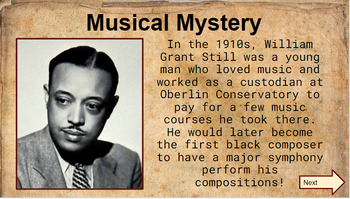Musical, Math Mystery - William Grant Still
- Google Slides™
- Internet Activities

Description
Students will use math skills and music knowledge to solve a mystery melody from African American composer, William Grant Still.
Students will have to use 2 and 3-digit addition, alpha-numeric grid coordinates, reading music notes on treble staff (with reference sheet) and transferring notes to a labeled, interactive xylophone. Students will have to use critical thinking skills to piece the clues together as historians, musicologists and detectives!
Hey musicologists,
Your help is needed to solve a mystery! The original manuscript of William Grant Still’s Afro-American Symphony has been found! His early composition of the main melody has been recovered from Oberlin Conservatory in Ohio where he studied music for a short time and is believed to be from 1928. The only problem is that the paper has gotten wet at some point and some ink has run making the end of the melody unreadable. Use clues found in the music room it was found in to complete the melody so it can be restored and sent to the National Museum of African-American Music in Tennessee. Work as a team, use clues found in the digital music room along with the additional materials from your teacher to solve the melody mystery and restore this important American artifact!




